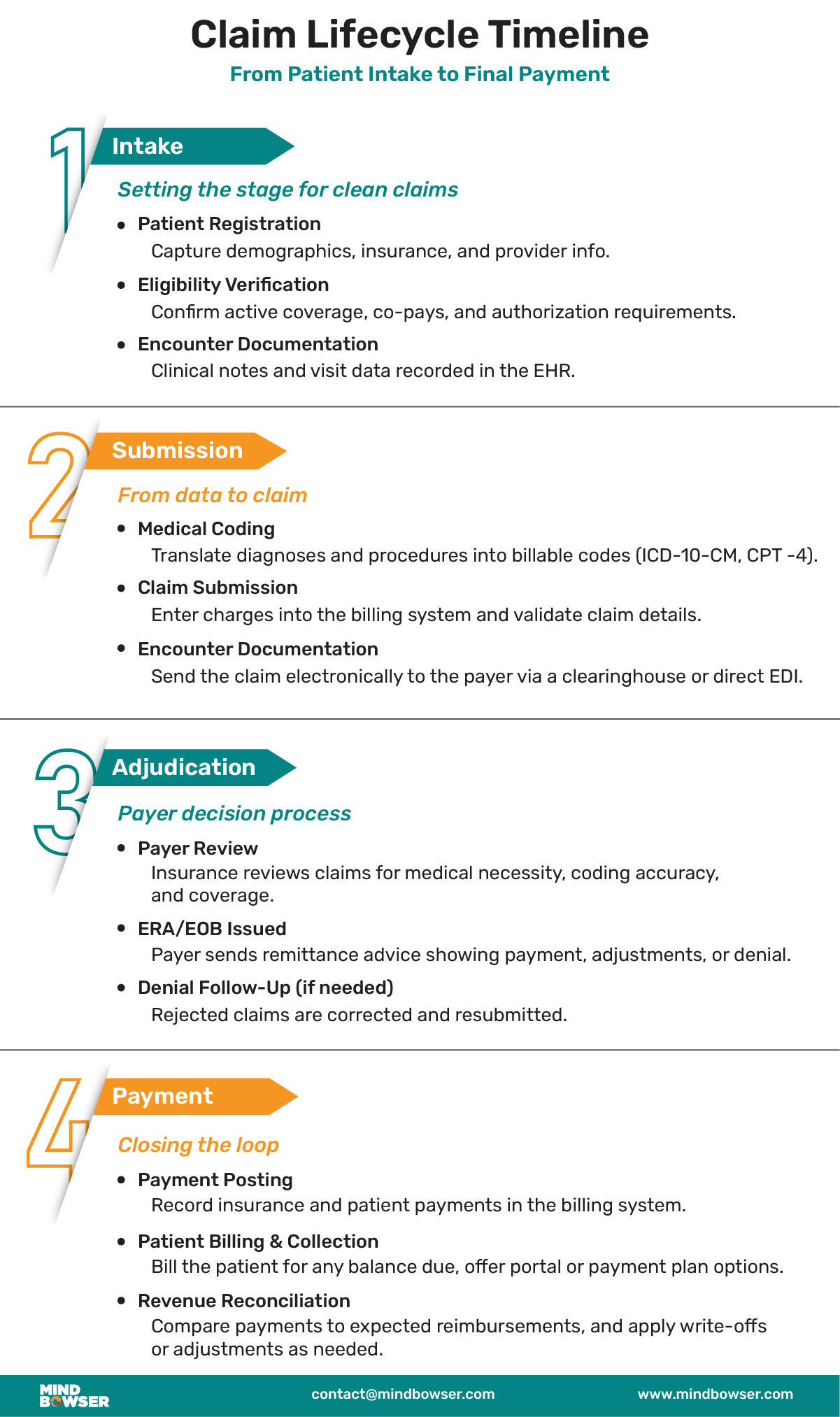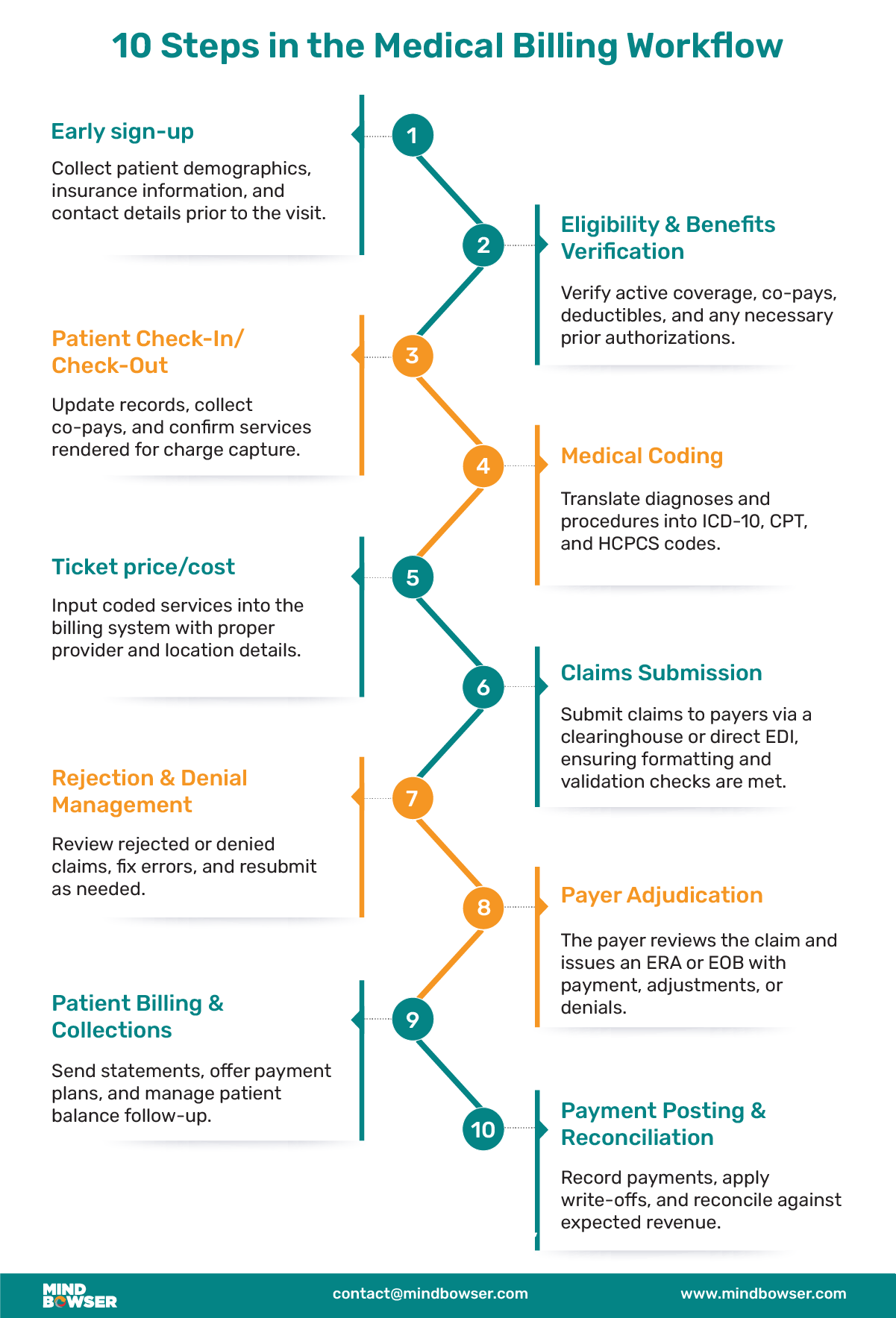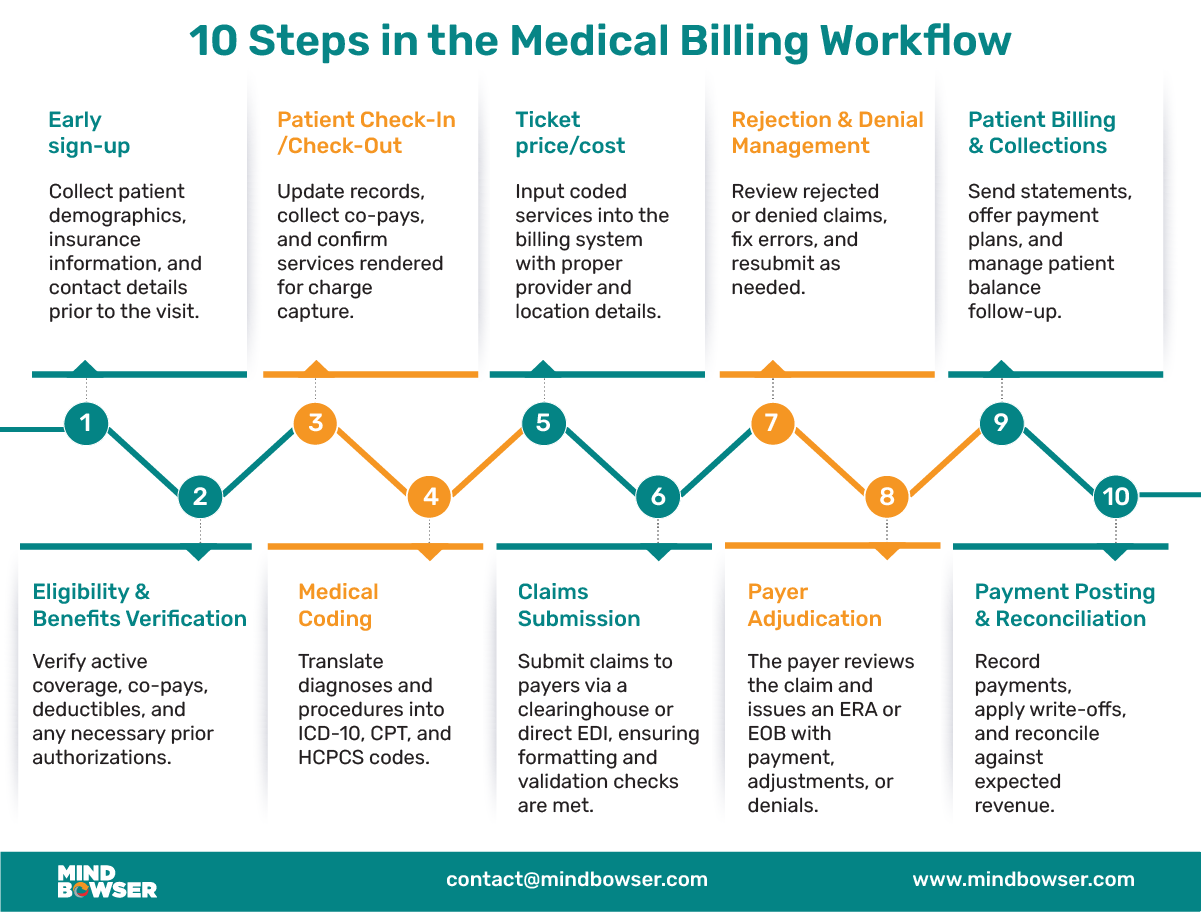According to industry estimates, U.S. healthcare providers lose over $125 billion every year due to billing inefficiencies. Those losses aren’t just about errors. They’re the result of fragmented workflows, outdated systems, delayed follow-ups, and poor communication across billing touchpoints.
In a healthcare environment already operating on thin margins, a single billing misstep can delay reimbursement, stall operational cash flow, and erode patient trust. Whether you’re a mid-sized hospital or a growing health system, your billing process isn’t just paperwork, it’s your revenue engine.
The question isn’t whether you have a billing process. The real question is: how well does it perform from start to finish?
Understanding the full arc of the billing cycle, from patient registration to final payment posting, is critical to maintaining financial integrity. In this guide, we’ll walk you through the 10 key steps in the medical billing process and explore how modern provider organizations are streamlining their revenue cycles through automation, enhanced analytics, and optimized workflows.
We’ll also highlight real examples, tech enablers, and strategies that have worked for our healthcare clients.
As Michael Archuleta, CIO at Mt. San Rafael Hospital and Clinics, put it in our podcast,
“We can no longer be a cost center, we must become strategic revenue contributors.” Nowhere is that more true than in medical billing, where process inefficiencies directly impact financial outcomes.
Medical billing isn’t just a back-office task; it’s a clinical-financial handshake. Every patient encounter triggers a chain reaction that affects how and when providers are paid. When that process breaks down, everything from cash flow to patient satisfaction to regulatory compliance is at risk.
Let’s walk through the foundation before we dive into the 10 steps.

When a provider renders care, whether it’s a routine screening or a surgical procedure, that interaction needs to be documented, coded, billed, and reimbursed. Any gap in that chain can delay or deny payment.
Too often, clinical teams hand off documentation and move on to other tasks. But for billing teams, that handoff is just the beginning. Every claim represents real revenue. Every denial reflects an operational blind spot.
If providers aren’t thinking about billing from the moment the patient registers, they’re already behind.
You’re not just billing for services; you’re collecting data points that drive analytics, inform compliance, and flag potential bottlenecks. When those inputs aren’t captured cleanly at the front end, downstream processes like claims submission, denial management, and reconciliation suffer.
A complete billing process involves everyone:
The handoffs between these stakeholders are often where errors and delays creep in.
Revenue Cycle Management (RCM) encompasses all administrative and clinical functions that contribute to the capture, management, and collection of patient service revenue.
It begins when a patient schedules an appointment and ends when their balance is zeroed out. Everything in between registration, eligibility verification, coding, billing, adjudication, patient collection, and payment posting falls under the RCM umbrella.
Medical billing is the operational core of that cycle.
Related read: A Guide to Healthcare Revenue Cycle Management
While RCM encompasses upstream activities, such as authorization, and downstream tasks, like collections, it’s the billing process that ties it all together. Billing is where you turn encounter data into financial outcomes. Done right, it helps providers:
For instance, we helped a healthcare technology provider that offers revenue cycle management solutions reduce its cloud infrastructure costs by 40% through a targeted migration effort. The operational savings created space to reinvest in high-impact initiatives, such as payer analytics and denial tracking, which directly support billing performance.
To truly understand what drives your cash flow, examine your billing process step by step. Each of the following ten actions contributes to whether your claims get paid on time, denied, or delayed indefinitely. Small inefficiencies in any one of these areas can snowball into serious revenue leakage.


Let’s walk through what happens from first contact to final payment.
What happens:
Before the patient even arrives, your front office or call center collects core demographic and insurance data. This includes name, address, date of birth, payer details, and the name of the referring physician (if applicable).
Operational goal:
Accurately input that data into your EHR or practice management system. This is not just administrative form-filling. It’s the foundation of clean claims.
Why it matters:
If you enter the insurance ID incorrectly or misspell a patient’s name, you may trigger a payer rejection or mismatch, which can delay payment. At scale, these “simple” errors can be expensive. Clean pre-registration reduces downstream rejections by up to 15%.
For example, we helped a maternity-focused care platform; automating pre-registration and CPT code generation through Epic integration reduced manual data entry by 80%. This structured intake improved billing accuracy and streamlined care coordination across departments.
What happens:
Staff verify that the patient has active insurance coverage for the scheduled services. This step also confirms copays, deductibles, authorization requirements, and any network limitations.
Tools:
Many practices use real-time eligibility checks through payer portals or integrated APIs. The goal is to eliminate surprises during the claims processing process.
Why it matters:
A patient with expired or inactive coverage will trigger an automatic denial. Catching issues up front also gives you the opportunity to collect upfront costs at check-in.
What happens at check-in:
You confirm the patient’s identity, update insurance or demographic changes, and collect any copays due.
What happens at check-out:
You ensure services have been rendered and coded, and that any necessary follow-ups or referrals are documented.
Process improvement tip:
Install patient portals or self-check-in kiosks. These reduce friction at the front desk and improve accuracy by letting patients verify their information.
Why it matters:
Every data point that flows from this step impacts downstream billing accuracy. When providers forget to document time, procedures, or referrals, it becomes your billing team’s problem.
What happens:
Coders translate the provider’s documentation into standardized billing codes using ICD-10, CPT, and HCPCS. These codes are how payers know what care was provided and what to reimburse.
Why it matters:
Even a single incorrect digit can turn into a denial. Upcoding can raise compliance flags. Undercoding leaves money on the table. And payer-specific coding rules change constantly.
Technology note:
AI-assisted coding tools are helping many large groups scale this step, especially for high-volume specialties. Still, trained human oversight is critical.
Related read: How to Build a Smart Medical Coding Automation System for Healthcare
What happens:
Once coding is complete, those charges are entered into the billing system. This step links services to the provider, location, and correct fee schedule.
Why it matters:
Charge entry errors are easy to overlook but can cause major reconciliation headaches later. Each service must be matched with the appropriate billing code, modifier, and provider information.
Efficiency tip:
Batch entry processes can help, but only if the source data is accurate. Regular audits of commonly used codes can prevent systemic charge leakage.
What happens:
Claims are generated and submitted electronically to payers through a clearinghouse or directly, depending on the payer relationship.
Important note:
Clearinghouses provide a valuable first-pass scrub to flag format errors or missing data before the claim reaches the payer. Some systems also run payer-specific edits.
Why it matters:
A well-formatted claim has a much higher first-pass acceptance rate. Claims that are rejected here can often be fixed without a formal denial, saving weeks of delay.
Visual idea:
Insert a process diagram illustrating a claim’s progression from provider to clearinghouse to payer, with key checks at each stage.
What happens:
Rejected claims (which never made it into payer systems) and denied claims (which were reviewed and refused) are reviewed by your billing or A/R team.
Tasks include:
Identifying the reason for rejection or denial, correcting the error, and resubmitting the claim.
Common causes:
What happens:
Payers review and process the claim. They determine which services are covered, how much they’ll pay, and what the patient owes.
You receive an Explanation of Benefits (EOB) or Electronic Remittance Advice (ERA), which outlines the result of the claim review.
Why it matters:
Adjudication is where everything comes to a head. If coding, documentation, eligibility, and submission are done correctly, this is the step that generates your revenue.
Pro tip:
Set up alerts for short-paid or underpaid claims to catch silent revenue loss. Don’t just assume the payer got it right.
What happens:
Any remaining balance after insurance is billed to the patient. Statements are sent, payment reminders go out, and your team handles questions, disputes, or payment plans.
Tools to consider:
Why it matters:
High out-of-pocket costs are a growing barrier for many patients. Make it easy for them to pay and transparent about what they owe. It will improve collection rates and reduce bad debt.
Tech tip:
Send balance notifications via SMS 24 hours before mailing physical statements. Response rates are significantly higher.
For example, on the collections side, we helped a healthcare platform implement mobile-friendly QR code billing and ACH payment options, significantly shortening patient payment cycles. Another organization leveraged one-click payments and automated billing history through Stripe integration, resulting in over $200,000 in annual savings on billing operations.
What happens:
Payments from payers and patients are recorded in your billing system. This includes adjusting for write-offs, discounts, and contractual obligations.
Tasks include:
Why it matters:
Without accurate payment posting, your reports will be incorrect. Without reconciliation, you can’t track shortfalls or predict revenue performance. This is the final step in closing the loop, and it needs to be tight.
KPI to watch:
Days in accounts receivable (A/R) should remain below 40 days for most practices. If it’s creeping higher, investigate upstream issues.
Even with a clearly defined 10-step workflow, the billing process is only as strong as the quality of its execution. The truth is, many revenue cycle leaders already know where their bottlenecks are. What they often lack is a structured, tech-enabled plan to fix them.
This section focuses on five core improvement areas that directly impact billing performance, particularly your clean claim rate, denial rate, and cash collection speed.
Where issues start:
More than half of billing errors can be traced back to the front end. Incorrect insurance info, missing referrals, and outdated patient demographics all begin at registration or check-in.
What to improve:
Stat to know:
Approximately 60% of all claim denials are attributed to front-end data entry errors.
Why it matters:
Every fix here reduces friction for the billing team later. Clean data upfront improves your first-pass acceptance rate and reduces manual rework.
What it means:
Claim scrubbing software checks your claims for errors or missing elements before they’re submitted to the payer. This includes missing modifiers, invalid diagnosis codes, mismatched patient info, and formatting issues.
How it works:
Most practices use a clearinghouse to scrub basic errors. But payer-specific edits often require advanced scrubbing engines or EHR-integrated tools.
How it helps:
Result:
Organizations that use scrubbing and automated edits consistently achieve clean claim rates above 95%.
Related read: Medical Billing vs Revenue Cycle Management: What’s the Real Difference?
Why this step matters:
Billing accuracy relies heavily on coding precision. But coding guidelines, especially from Medicare and commercial payers, change frequently. Unless your team stays up-to-date, denials are inevitable.
Best practices:
Watch for:
Compliance reminder:
Accurate coding doesn’t just impact reimbursement; it also reduces audit risk.
Why it matters:
If you’re not tracking performance, you’re guessing. Every billing department should have visibility into key performance indicators that tell the story of how well claims are moving through the system.
Core KPIs to monitor:
How to improve visibility:
Tip:
Even small providers can track these metrics using a Google Sheet, BI tool, or built-in EHR analytics.
Why it’s often overlooked:
Once the claim is adjudicated and the payer pays their share, providers are still responsible for collecting balances from patients. And for many practices, this is where revenue goes uncollected.
Modern patient billing should include:
Why this works:
When patients understand what they owe and can pay easily, they’re more likely to follow through. Reducing barriers increases cash flow and lowers collection costs.
Bonus insight:
Adding a branded SMS payment reminder increased collection rates by 28 percent for one of our regional client partners.
As Kyle Kiser of Arrive Health pointed out in the HealthTech with Purpose Podcast Series,
“Most patients don’t know what something costs until weeks later, after a third-party payer processes it. ‘It just doesn’t make sense,’ he said, and patients are right to feel frustrated. Clear statements, real-time billing, and self-pay tools can fix that disconnect.”
For provider organizations under pressure to protect margins, billing is more than a transactional process. It is the operational core of your entire revenue cycle. If it’s working well, it strengthens every downstream financial function from A/R to reporting. If it’s broken, you’re leaking revenue, wasting staff time, and frustrating patients.
Let’s examine how billing fits into the broader picture of revenue cycle management and why improving this aspect alone can yield significant results.
Your billing data reflects more than payments. It shows:
The trends in those metrics and your ability to respond to them influence everything from staffing to growth planning.
Practical insight:
If your days in accounts receivable (A/R) are creeping past 40, or your net collection rate is under 95%, billing is often the first place to investigate.
If a single claim submission is delayed or denied, the impact isn’t isolated. It holds up patient statements, reduces cash available for payroll or vendors, and distorts your month-end reporting. Multiply that by hundreds or thousands of claims per week, and the stakes become clear.
Even when care delivery is exceptional, you won’t see the revenue unless billing teams accurately capture charges, apply codes precisely, and strictly adhere to payer rules.
In short, your clinical outcomes won’t sustain your business; your billing outcomes will.
Many mid-sized hospitals and physician groups still rely on manual processes or disconnected systems for parts of their billing operations. These include:
Each of these steps introduces delay, duplication, or error, often all three.
Result: Staff time gets consumed by rework instead of revenue-generating activities.
A well-integrated revenue cycle platform connects every touchpoint: scheduling, eligibility checks, coding, charge entry, claims, remits, patient collections, and payment posting.
Benefits of integrated RCM platforms include:
Even with a well-documented billing process and the right tools in place, roadblocks can still occur. What separates high-performing billing teams from struggling ones isn’t perfection, it’s consistency in spotting issues early and resolving them systematically.
Here are the most common billing challenges we encounter across provider organizations, along with specific strategies to address each.
Patients move. Insurance plans change. If front-end systems don’t capture those changes accurately, claims are rejected for things as small as a typo or a missing suffix.
Fix:
Implement a standardized intake verification checklist at every visit. Use real-time eligibility tools to catch active coverage gaps before the appointment.
Authorizations are time-sensitive and often tied to specific service codes. Submitting claims without valid prior auth leads to automatic denials from payers and a very small chance of appeal.
Fix:
Set up task-based reminders tied to EHR scheduling workflows. Track upcoming expiration dates for authorizations and ensure they align with the services billed.
This is one of the top drivers of payer denials. Coding errors occur when documentation is incomplete, codes are outdated, or provider intent is not accurately captured.
Fix:
Use integrated coding tools that flag missing modifiers and inconsistent diagnosis-procedure pairings. Consider periodic coding audits, especially for high-volume service lines.
Payer rejections often fall into a dead zone. They’re not full denials, so they don’t trigger escalations, but they sit unresolved in work queues, holding up revenue.
Fix:
Designate a rejection workgroup and build a daily queue report. Track response times and ensure that high-volume rejections receive root-cause analysis.
If you’re resubmitting the same errors over and over, you’re not managing a revenue cycle; you’re babysitting broken processes.
Fix:
Maintain a living denial-reason log. Tag each resubmission with a root cause category and review it monthly to identify the top repeat errors.
Industry data shows each appealed claim costs between $25 and $118 in staff time. And most appeals take weeks. The longer it sits, the lower your odds of recovering full reimbursement.
Fix:
Prioritize automation for resubmissions that involve formatting or documentation gaps. Only escalate complex appeals manually.
Whether intentional or unintentional, inaccurate coding can raise red flags with payers and regulators. Upcoding (billing for a more complex service than performed) can lead to audits. Downcoding (underbilling) leaves revenue on the table and often goes unnoticed.
Fix:
Audit 10% of high-value encounters on a monthly basis. Cross-check documentation against billed codes. Train providers to recognize gray areas, such as time-based billing, new versus established patients, and split/shared visits.
Payers increasingly request documentation after submission, especially for high-dollar claims. If documentation isn’t available or doesn’t support the submitted codes, payment will be denied and prior payouts will be recouped.
Fix:
Use EHR alerts to require key documentation fields before finalizing the note. Ensure coding and billing teams have access to supporting notes without needing to toggle between systems.
Without a clear audit trail of how each claim was handled, from original charge entry to final payment, your organization is vulnerable to any payer or CMS review.
Fix:
Document every touchpoint in the billing platform. Assign user roles for accountability. Use system logs to trace adjustments, notes, and resubmissions.
Medical billing is no longer just about coding accuracy and payer rules; it has evolved to encompass a broader range of responsibilities. It’s also about how effectively your systems communicate with each other and how efficiently your staff can utilize them. The right tech stack doesn’t replace billing teams. It amplifies their work and reduces time spent chasing avoidable issues.
Here are the three categories of tools every revenue-focused provider organization should consider as part of a modern billing operation.
When your billing and clinical systems operate in silos, revenue loss is inevitable. Duplicate data entry, missed charges, and inconsistent information across systems all lead to avoidable denials or delays.
Symptoms of poor integration include:
Operational tip:
Every extra click between systems adds risk. Your tools should reduce toggling, not increase it.
Claim scrubbers act as the first line of defense before a claim ever hits the payer’s system. They flag:
Clearinghouses then serve as intermediaries, routing scrubbed claims to payers, receiving electronic remittance advices (ERAs), and alerting teams to rejections in near real-time.
Patients are increasingly responsible for a growing share of healthcare costs, and healthcare provider systems must adapt accordingly. Static statements and mailed invoices no longer cut it.
Modern billing teams need digital tools that meet patients where they are.
Data point:
Practices that use SMS payment links collect balances 23 percent faster on average than those that use mailed statements alone.
Best practice:
Bundle statements with visit summaries and EOB explanations, so patients don’t need to call to understand what they’re being charged for.
Revenue impact:
Faster patient payments reduce reliance on external collections and improve cash flow predictability.
You don’t need another generic billing software vendor. You need a partner who understands the realities of healthcare workflows, compliance pressure, and what it takes to keep revenue moving while care teams stay focused on patients.
At Mindbowser, we work closely with provider organizations to streamline billing operations from the inside out by leveraging technology, but by removing complexity.
Here’s what that looks like in practice:
Whether you’re looking to streamline a single piece of your billing workflow or rebuild your RCM infrastructure from the ground up, we move quickly, with compliance, scalability, and payer nuance built in.
We work with:
Bottom line: If billing bottlenecks are slowing down revenue, patient experience, or staffing, we’re ready to help.

If you’ve made it this far, you already understand the reality: billing is not just a clerical function; it’s the heartbeat of your revenue cycle.
From the moment a patient schedules an appointment to the final payment reconciliation, each billing step either moves your organization closer to financial clarity or further into friction. When these processes are aligned, payers reimburse faster, patients trust the billing experience, and your staff spends less time chasing down rework.
Here’s what matters most:
This is not just about compliance or cash flow. It’s about ensuring your operations support your care delivery, not hinder it.
At Mindbowser, we collaborate with hospitals, medical groups, and digital health platforms to streamline their billing workflows, minimize avoidable denials, and enhance patient collection experiences. Whether you need to integrate smarter claim scrubbing or plug billing insights directly into your EHR, we bring the tools and healthcare context to move fast and get it right.
📌 Let’s clean up your revenue cycle.
Book a free discovery call with our billing specialists.
The 10 core steps are:
Each step contributes to timely, accurate reimbursement. Small breakdowns in any one area can lead to claim delays or denials.
Revenue cycle management (RCM) is the full financial lifecycle of a patient encounter. It spans from scheduling and registration to claim submission, payment posting, and patient collections.
Billing is a core component of RCM; it’s where clinical data is converted into financial revenue. Clean billing processes help improve KPIs like days in A/R, clean claim rate, and net collection percentage.
Begin by identifying the source of the denials. Most are caused by:
You can reduce denials by:
A living denial reason log helps track trends and inform retraining.
The most important medical billing KPIs include:
Patient collection rate – how much of the patient balances are collected
Monitoring these KPIs on a monthly (or weekly) basis helps identify red flags early.

We worked with Mindbowser on a design sprint, and their team did an awesome job. They really helped us shape the look and feel of our web app and gave us a clean, thoughtful design that our build team could...


The team at Mindbowser was highly professional, patient, and collaborative throughout our engagement. They struck the right balance between offering guidance and taking direction, which made the development process smooth. Although our project wasn’t related to healthcare, we clearly benefited...

Founder, Texas Ranch Security

Mindbowser played a crucial role in helping us bring everything together into a unified, cohesive product. Their commitment to industry-standard coding practices made an enormous difference, allowing developers to seamlessly transition in and out of the project without any confusion....

CEO, MarketsAI

I'm thrilled to be partnering with Mindbowser on our journey with TravelRite. The collaboration has been exceptional, and I’m truly grateful for the dedication and expertise the team has brought to the development process. Their commitment to our mission is...

Founder & CEO, TravelRite

The Mindbowser team's professionalism consistently impressed me. Their commitment to quality shone through in every aspect of the project. They truly went the extra mile, ensuring they understood our needs perfectly and were always willing to invest the time to...

CTO, New Day Therapeutics

I collaborated with Mindbowser for several years on a complex SaaS platform project. They took over a partially completed project and successfully transformed it into a fully functional and robust platform. Throughout the entire process, the quality of their work...

President, E.B. Carlson

Mindbowser and team are professional, talented and very responsive. They got us through a challenging situation with our IOT product successfully. They will be our go to dev team going forward.

Founder, Cascada

Amazing team to work with. Very responsive and very skilled in both front and backend engineering. Looking forward to our next project together.

Co-Founder, Emerge

The team is great to work with. Very professional, on task, and efficient.

Founder, PeriopMD

I can not express enough how pleased we are with the whole team. From the first call and meeting, they took our vision and ran with it. Communication was easy and everyone was flexible to our schedule. I’m excited to...

Founder, Seeke

We had very close go live timeline and Mindbowser team got us live a month before.

CEO, BuyNow WorldWide

Mindbowser brought in a team of skilled developers who were easy to work with and deeply committed to the project. If you're looking for reliable, high-quality development support, I’d absolutely recommend them.

Founder, Teach Reach

Mindbowser built both iOS and Android apps for Mindworks, that have stood the test of time. 5 years later they still function quite beautifully. Their team always met their objectives and I'm very happy with the end result. Thank you!

Founder, Mindworks

Mindbowser has delivered a much better quality product than our previous tech vendors. Our product is stable and passed Well Architected Framework Review from AWS.

CEO, PurpleAnt

I am happy to share that we got USD 10k in cloud credits courtesy of our friends at Mindbowser. Thank you Pravin and Ayush, this means a lot to us.

CTO, Shortlist

Mindbowser is one of the reasons that our app is successful. These guys have been a great team.

Founder & CEO, MangoMirror

Kudos for all your hard work and diligence on the Telehealth platform project. You made it possible.

CEO, ThriveHealth

Mindbowser helped us build an awesome iOS app to bring balance to people’s lives.

CEO, SMILINGMIND

They were a very responsive team! Extremely easy to communicate and work with!

Founder & CEO, TotTech

We’ve had very little-to-no hiccups at all—it’s been a really pleasurable experience.

Co-Founder, TEAM8s

Mindbowser was very helpful with explaining the development process and started quickly on the project.

Executive Director of Product Development, Innovation Lab

The greatest benefit we got from Mindbowser is the expertise. Their team has developed apps in all different industries with all types of social proofs.

Co-Founder, Vesica

Mindbowser is professional, efficient and thorough.

Consultant, XPRIZE

Very committed, they create beautiful apps and are very benevolent. They have brilliant Ideas.

Founder, S.T.A.R.S of Wellness

Mindbowser was great; they listened to us a lot and helped us hone in on the actual idea of the app. They had put together fantastic wireframes for us.

Co-Founder, Flat Earth

Mindbowser was incredibly responsive and understood exactly what I needed. They matched me with the perfect team member who not only grasped my vision but executed it flawlessly. The entire experience felt collaborative, efficient, and truly aligned with my goals.

Founder, Child Life On Call

The team from Mindbowser stayed on task, asked the right questions, and completed the required tasks in a timely fashion! Strong work team!

CEO, SDOH2Health LLC

Mindbowser was easy to work with and hit the ground running, immediately feeling like part of our team.

CEO, Stealth Startup

Mindbowser was an excellent partner in developing my fitness app. They were patient, attentive, & understood my business needs. The end product exceeded my expectations. Thrilled to share it globally.

Owner, Phalanx

Mindbowser's expertise in tech, process & mobile development made them our choice for our app. The team was dedicated to the process & delivered high-quality features on time. They also gave valuable industry advice. Highly recommend them for app development...

Co-Founder, Fox&Fork
